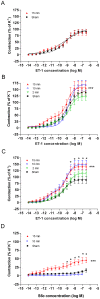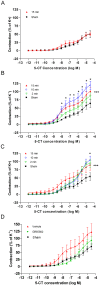Expressional changes in cerebrovascular receptors after experimental transient forebrain ischemia
- PMID: 22848635
- PMCID: PMC3407123
- DOI: 10.1371/journal.pone.0041852
Expressional changes in cerebrovascular receptors after experimental transient forebrain ischemia
Abstract
Background: Global ischemic stroke is one of the most prominent consequences of cardiac arrest, since the diminished blood flow to the brain results in cell damage and sometimes permanently impaired neurological function. The post-arrest period is often characterised by cerebral hypoperfusion due to subacute hemodynamic disturbances, the pathophysiology of which are poorly understood. In two other types of stroke, focal ischemic stroke and subarachnoid hemorrhage, it has earlier been demonstrated that the expression of certain vasoconstrictor receptors is increased in cerebral arteries several days after the insult, a phenomenon that leads to increased contraction of cerebral arteries, reduced perfusion of the affected area and worsened ischemic damage. Based on these findings, the aim of the present study was to investigate if transient global cerebral ischemia is associated with upregulation of vasoconstrictive endothelin and 5-hydroxytryptamine receptors in cerebral arteries. Experimental transient forebrain ischemia of varying durations was induced in male wistar rats, followed by reperfusion for 48 hours. Neurological function was assessed daily by three different tests and cerebrovascular expression and contractile function of endothelin and 5-hydroxytryptamine receptors were evaluated by wire myography, immunohistochemistry and western blotting.
Results: Transient forebrain ischemia induced neurological deficits as well as functional upregulation of vasoconstrictive ET(B) and 5-HT(1B) receptors in cerebral arteries supplying mid- and forebrain regions. No receptor upregulation was seen in arteries supplying the hindbrain. Immunohistochemical stainings and western blotting demonstrated expressional upregulation of these receptor subtypes in the mid- and forebrain arteries and confirmed that the receptors were located in the smooth muscle layer of the cerebral arteries.
Conclusions: This study reveals a new pathophysiological aspect of global ischemic stroke, namely expressional upregulation of vasoconstrictor receptors in cerebral arteries two days after the insult, which might contribute to cerebral hypoperfusion and delayed neuronal damage after cardiac arrest.
Conflict of interest statement
Figures





 SEM in percentages of the mean staining intensity in control-operated (sham) animals. Significant differences between sham-operated and 15 minutes ischemia rats were determined using student´s t-test. *p< 0.05.
SEM in percentages of the mean staining intensity in control-operated (sham) animals. Significant differences between sham-operated and 15 minutes ischemia rats were determined using student´s t-test. *p< 0.05.


Similar articles
-
Early MEK1/2 inhibition after global cerebral ischemia in rats reduces brain damage and improves outcome by preventing delayed vasoconstrictor receptor upregulation.PLoS One. 2014 Mar 18;9(3):e92417. doi: 10.1371/journal.pone.0092417. eCollection 2014. PLoS One. 2014. PMID: 24642693 Free PMC article.
-
In vivo experimental stroke and in vitro organ culture induce similar changes in vasoconstrictor receptors and intracellular calcium handling in rat cerebral arteries.Exp Brain Res. 2012 Jun;219(4):507-20. doi: 10.1007/s00221-012-3108-6. Epub 2012 May 15. Exp Brain Res. 2012. PMID: 22585122
-
Improvement in neurological outcome and abolition of cerebrovascular endothelin B and 5-hydroxytryptamine 1B receptor upregulation through mitogen-activated protein kinase kinase 1/2 inhibition after subarachnoid hemorrhage in rats.J Neurosurg. 2011 Apr;114(4):1143-53. doi: 10.3171/2010.6.JNS1018. Epub 2010 Jul 2. J Neurosurg. 2011. PMID: 20597604
-
Vascular plasticity in cerebrovascular disorders.J Cereb Blood Flow Metab. 2011 Jul;31(7):1554-71. doi: 10.1038/jcbfm.2011.70. Epub 2011 May 11. J Cereb Blood Flow Metab. 2011. PMID: 21559027 Free PMC article. Review.
-
Endothelin and subarachnoid hemorrhage: an overview.Neurosurgery. 1998 Oct;43(4):863-75; discussion 875-6. doi: 10.1097/00006123-199810000-00083. Neurosurgery. 1998. PMID: 9766314 Review.
Cited by
-
Early MEK1/2 inhibition after global cerebral ischemia in rats reduces brain damage and improves outcome by preventing delayed vasoconstrictor receptor upregulation.PLoS One. 2014 Mar 18;9(3):e92417. doi: 10.1371/journal.pone.0092417. eCollection 2014. PLoS One. 2014. PMID: 24642693 Free PMC article.
-
Regulatory mechanism of endothelin receptor B in the cerebral arteries after focal cerebral ischemia.PLoS One. 2014 Dec 5;9(12):e113624. doi: 10.1371/journal.pone.0113624. eCollection 2014. PLoS One. 2014. PMID: 25479176 Free PMC article.
-
Endothelin.Pharmacol Rev. 2016 Apr;68(2):357-418. doi: 10.1124/pr.115.011833. Pharmacol Rev. 2016. PMID: 26956245 Free PMC article. Review.
-
Enhancement of bradykinin-induced relaxation by focal brain ischemia in the rat middle cerebral artery: Receptor expression upregulation and activation of multiple pathways.PLoS One. 2018 Jun 18;13(6):e0198553. doi: 10.1371/journal.pone.0198553. eCollection 2018. PLoS One. 2018. PMID: 29912902 Free PMC article.
-
Near-infrared transillumination back scattering sounding--new method to assess brain microcirculation in patients with chronic carotid artery stenosis.PLoS One. 2013 Apr 17;8(4):e61936. doi: 10.1371/journal.pone.0061936. Print 2013. PLoS One. 2013. PMID: 23613977 Free PMC article. Clinical Trial.
References
-
- Hossmann KA (2008) Cerebral ischemia: models, methods and outcomes. Neuropharmacology 55: 257–270. S0028–3908(07)00391–7 [pii];10.1016/j.neuropharm.2007.12.004 [doi]. - DOI - PubMed
-
- Schneider A, Bottiger BW, Popp E (2009) Cerebral resuscitation after cardiocirculatory arrest. Anesth Analg 108: 971–979. 108/3/971 [pii];10.1213/ane.0b013e318193ca99 [doi]. - DOI - PubMed
-
- Harukuni I, Bhardwaj A (2006) Mechanisms of brain injury after global cerebral ischemia. Neurol Clin 24: 1–21. S0733–8619(05)00084–8 [pii];10.1016/j.ncl.2005.10.004 [doi]. - DOI - PubMed
-
- Bass E (1985) Cardiopulmonary arrest. Pathophysiology and neurologic complications. Ann Intern Med 103: 920–927. - PubMed
-
- Richmond TS (1997) Cerebral resuscitation after global brain ischemia: linking research to practice. AACN Clin Issues 8: 171–181. - PubMed
Publication types
MeSH terms
Substances
LinkOut - more resources
Full Text Sources
Medical

